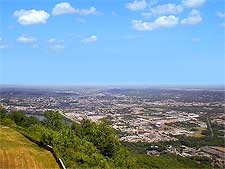Chattanooga History Facts and Timeline
(Chattanooga, Tennessee - TN, USA)

As a key southern hub in Tennessee, Chattanooga has a modern history dating back nearly 250 years and the city played a significant role in the relocation of Native Indians, as well as the Civil War.
The flooding of the Tennessee Valley over the years has also occasionally put this industrial city in the news.
The Early Years
While the Chattanooga area has been inhabited by Cherokee Indians for more than a millennium, the site of today's city was first established as a settlement by Native Americans during the resistance wars towards the end of the 18th century, with its name allegedly derived from a Muskegan phrase for 'big catch'. Surrounded as it is by the remnants of the Appalachian Mountains, it was well defended and even today is noted as the 'Scenic City'.
The city was first named Ross's Landing after John Ross became the principal chief of the area. Ironically, he was a native Indian himself, but the town became a major staging point and detention centre during the mass relocation of the Cherokee from Tennessee to Oklahoma during the infamous 'Trail of Tears' era.
In 1838, it was formally incorporated as a city known as Chattanooga and rapidly became a boom town for its status as a transport hub on the river, thanks in part to the arrival of the railroad in 1850. 'Where Cotton Meets Corn' became its motto since the city was a cultural boundary between these two key agricultural areas of the American heartland.

American Civil War
Chattanooga also has a place in American Civil War history. During the Chickamauga campaign, the Union army retreated here and eventually fought a key battle with the Confederate forces in the Battle for Lookout Hill during November 1863. The Southern army was routed in one of the key events that eventually turned the tide against them.
Flooding has also been a key event several times during the city's history, with the worst occurring before the Tennessee Valley Authority (TVA) was set up as a Depression-era initiative. Some parts of the valley were under 20 meters / 66 feet of water during the worst of the flooding, although more recent floods have been much less severe as a result of the TVA's efforts in the 1930s.
Economy
Sometimes referred to as the Dynamo of Dixie, Chattanooga emerged as a major industrial hub for the region through the mid-20th century, but this would eventually backfire on the fortunes of the city during the 1980s when the Rust Belt syndrome of the Midwest also left its mark here. Serious socio-economic problems from de-industrialisation and layoffs led to the shrinking of the population by more than 10 percent.
Luckily, revival plans helped turn the tide and Chattanooga became one of the few US cities suffering from this syndrome to revive its economy and recover. Today, it is noted as a very liveable southern city and ranks as one of the 'best bang for your buck' places to live in the US.
 As a key southern hub in Tennessee, Chattanooga has a modern history dating back nearly 250 years and the city played a significant role in the relocation of Native Indians, as well as the Civil War.
As a key southern hub in Tennessee, Chattanooga has a modern history dating back nearly 250 years and the city played a significant role in the relocation of Native Indians, as well as the Civil War.